I've always wondered why computer graphic cards use an 8 pin (4 positive and 4 negative wires) connector instead of a connector with only a single positive and negative wire.
-
4Related: Why do we make wires using stranded conductors? How big would a single ground wire have to be to give the same **contact area** as these four ground wires combined have? – Ben Voigt Dec 29 '17 at 16:01
5 Answers
This allows multiple cheap connectors and wires to be used, instead of single thick wires and more expensive high current connectors. Multiple thin wires are also more flexible than thick wires. Multiple pins on the circuit board ease the problem of tracking high currents on a PCB.
It's not just about power handling, it's the voltage drop on the cable that needs to be well controlled.
- 158,152
- 3
- 173
- 387
-
1then essentially the total current is divided into multiple wires basically kirchoff current law – loki floki Dec 29 '17 at 13:25
-
8
-
6@Whiskeyjack: The system, maybe, but not necessarily the _whole_ system. If the pairs end up running power to different sections, breaking a wire could take that section down. – cHao Dec 29 '17 at 17:19
-
@cHao - Yeah you are right. However my gut feeling is that since all wires are coming at the same part of the PCB, they might as well combine them and put decoupling caps on the combined line itself. However it's just a gut feeling and I am no expert. :) – Whiskeyjack Dec 29 '17 at 17:38
-
5@Whiskeyjack FWIW, in many high-power GPUs (my Radeons included), the different V+ wires *aren't* interconnected - because every wire has to supply a distinct power to the GPU, they are often isolated so that they can be supplied from multiple PSUs without any PSU interconnection issues etc. Only GND is usually interconnected, because it simply has to be for the multi-PSU setup to work. Essentially, cHao is completely right here. You could be right for some low-end GPUs - but they seldom use separate power connections anyway... – Dec 30 '17 at 12:44
-
1
-
The flexibility aspect is important. A pair of fat wires could apply quite a lot of force to the connector, potentially damaging the tracks (especially as you'd then only have 2 pins to spread the load) – Chris H Dec 30 '17 at 16:56
-
Doesn't hold. Thicker wire is cheaper per cross section area, because insulation is expensive. Putting insulation on 4 wires costs more than putting insulation on one twice the diameter. Related: square-cube law. – Harper - Reinstate Monica Dec 30 '17 at 18:11
-
@Harper, don't forget bulk discounts. PSU manufacturers use a *lot* of the smaller gauge wires as depicted, as they are also used in all other power supply cabling. For them, using multiples of the same (thin) wire where needed might be cheaper than buying separate thicker wire for this purpose. – Mels Dec 31 '17 at 00:12
-
@Mels That would make sense if power supplies were built in small quantity. But at 100,000+ quantity, you use a lot of everything... so it all equalizes. My theory is flexibility is the issue. The 2x diameter wire would be so stiff it would flex/damage the video card. – Harper - Reinstate Monica Dec 31 '17 at 01:12
-
Don't forget about remote sense! The 8 pin PCIe power connector actually has 6 power pins and 2 sense pins, enabling the power supply to compensate for voltage drop through the cable. – alex.forencich Dec 31 '17 at 08:15
-
@Harper don't underestimate how far bulk discounts can go. Regardless of quantity, they'd still be using roughly an order of magnitude more (in length) of the thin gauge wire than the thicker gauge. Then there's the additional tooling costs for different connectors - that would essentially be a whole separate production line that needs to be purchased and maintained, where the current PCIe power connectors can take a free ride in the same molex style crimping assembly lines they use for all the other connectors. – Mels Dec 31 '17 at 15:03
-
@mels my experience is more on the automotive side. Which connectors are available for GM to build cars out of? Anything GM wants. Anything. And automakers are crazy about squeezing a tenth of a penny of cost, with component makers all over the world happy to oblige. And they build in an order of magnitude smaller quantity than PC/PSU vendors. – Harper - Reinstate Monica Dec 31 '17 at 19:36
- To allow for more current than a single connection can reliably provide.
- For lower overall resistance, and therefore lower voltage drop.
- For redundancy as individual connections increase in resistance due to oxidation, dirt, etc, as they age.
- 310,974
- 36
- 428
- 915
-
4
-
5. To support remote voltage sensing to compensate for voltage drop. – alex.forencich Dec 31 '17 at 10:06
According to the PCIe Electromechanical Specifications, power connectors are specified to deliver +12 V, and a 2x3 connector can deliver 75 W, or 150 W for a 2x4. High power PCIe devices (GPUs generally) can pull up to 300 W through a combination of PCIe power connectors and 25 W from the edge connector.
In chapter 3 of the document, it mentions:
- The +12V delivered from the standard x16 edge connector and the additional +12V(s) delivered via the dedicated 2 x 3 and/or 2 x 4 auxiliary power connector(s) must be treated as coming from independent separate system power supply rails.
- The different +12V input potentials from different connectors must not be electrically shorted at any point on a PCI Express 225 W/300 W add-in card.
- The power pins of a single 2 x 3 or 2 x 4 auxiliary power connector can be shorted together.
So per-connector there may be no difference according to spec if all the wires were combined in the harness, thought splitting it out to all the pins of the Molex connector would be costly.
I don't know how the wiring is actually done in the power supplies, but the supplies are generally split into a few rails. Combining them closer to the point of load might help with some regulation.
On the GPU there's usually several (10-20) voltage phases that combined can deliver ~200 A @ 1 V into the GPU core and memory. As an example, the Nvidia Titan V has a 2x3 and 2x4 connector and can produce up to 250 W of heat. GamersNexus did a teardown of one and looked at the power delivery circuitry:
- 12,360
- 2
- 44
- 71
-
416x PCI-Express cards can draw up to 75W total from the edge connector and this is necessary to get the full 300W (75W edge + 75W 6-pin + 150W 8-pin). – Ross Ridge Dec 29 '17 at 22:26
Several reasons, all stemming from the fact that GPUs draw a lot of current.
A GPU might draw 100 W through one of those connectors. At 12 volts, that's 8 amps. High current through a wire will produce a voltage drop from one end of the wire to the other, proportional to the resistance of the wire. This results in a lower voltage at the GPU and lost power in the wire, resulting in less efficiency in the power transfer and more heat in the case.
The voltage drop can be mitigated in two main ways: one is by lowering the resistance of the wiring, either by using larger wires or by placing multiple wires in parallel. Lowering the resistance means less voltage drop and more efficiency. Another solution is to add an additional voltage sense wire that does not carry current so the power supply can sense and adjust the voltage at the load, compensating for voltage drop in the wires.
Another factor in play is mechanical concerns. Thick wires are less flexible than thin wires, resulting in more difficult cable routing, bend radius concerns, and increased stress on connectors and circuit boards. Using multiple pins also increases contact surface area, decreasing contact resistance. Parallel current paths also provides some level of redundancy.
The 8 pin PCIe power connector uses both of these solutions: three parallel power pins, three parallel ground pins, and a pair of voltage sense pins. Using three parallel power pins lowers the voltage drop through the cable while also providing good flexibility while the sense pins ensure that the load is actually receiving 12 volts.
- 40,694
- 1
- 68
- 109
The answer is more mundane, the 2x3 and 2x4 connectors are available in "all" systems as they are the default output on the power supply. And as they are available they don't need special power supplies to have 75W or 100W outputs.
Also the lower individual power might simplify the transformers on the GPU card, using smaller components.
- 129
- 2

